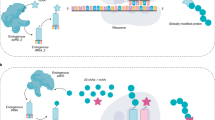Abstract
The hydantoinase process is used for the large-scale production of optically pure amino acids, with side chains of semisynthetic penicillins as the most prominent products. The origin as well as the natural function of the eponymous enzymes, however, remains unclear to this day. Here we discuss the way of hydantoinases from prebiotic evolution to directed evolution, spanning some billion years from the origin of life to industrial processes.
Similar content being viewed by others
Literatur
Engel U, Rudat J, Syldatk C (2014) The Hydantoinase Process: Recent developments for the production of non-canonical amino acids. In: Grunwald P (Hrsg) Industrial Biocatalysis (Kap 22). Pan Stanford Publishing Pte. Ltd., Singapore
Nelson KE, Metthew L, Miller SL (2000) Peptide nucleic acids rather than RNA may have been the first genetic molecule. Proc Natl Acad Sci USA 97:3868–3871
Parker ET, Cleaves JH, Callahan MP et al. (2011) Prebiotic synthesis of methionine and other sulfur containing organic compounds on the primitive earth. Orig Life Evol Biosph 41:201–212
Robertson MP, Miller SL (1995) An efficient prebiotic synthesis of cytosine and uracil. Nature 375:772–774
Kuszmann J, Márton-Merész M, Jerkovich G (1988) Application of the Bucherer reaction to carbohydrate derivatives. Carbohyd Res 175:249–264
Höss M, Jaruga P, Zastawny TH et al. (1996) DNA damage and DNA sequence retrieval from ancient tissues. Nucleic Acids Res 24:1304–1307
Engel U, Syldatk C, Rudat J (2012) Stereoselective hydrolysis of aryl-substituted dihydropyrimidines by hydantoinases. Appl Microbiol Biotechnol 94:1221
Syldatk C, May O, Altenbuchner J et al. (1999) Microbial hydantoinases: industrial enzymes from the origin of life? Appl Microbiol Biotechnol 5:293–309
Slomka C, Engel U, Syldatk C et al. (2015) Hydrolysis of hydantoins, dihydropyrimidines and related compounds. In: Faber K, Fessner W-D, Turner NJ (Hrsg) Science of Synthesis: Biocatalysis in Organic Synthesis. Thieme, Stuttgart, S 373–414
May O, Nguyen PT, Arnold FH (2000) Inverting enantioselectivity by directed evolution for improved production of L-methionine. Nat Biotech 18:317–320
Arnold FH, May O, Drauz K et al. (2005) Hydantoinase variants with improved properties and their use for the production of amino acids. California Institute of Technology (US), Degussa (DE), Patent EP1165763 B1
Slomka C, Zhong S, Fellinger A et al. (2015) Chemical synthesis and enzymatic, stereoselective hydrolysis of a functionalized dihydropyrimidine for the synthesis of β-amino acids. AMB Express 5:85
Author information
Authors and Affiliations
Corresponding author
Rights and permissions
About this article
Cite this article
Rudat, J., Engel, U. Hydantoinasen – von der präbiotischen Evolution zur Aminosäureproduktion. Biospektrum 23, 98–100 (2017). https://doi.org/10.1007/s12268-017-0770-z
Published:
Issue Date:
DOI: https://doi.org/10.1007/s12268-017-0770-z




